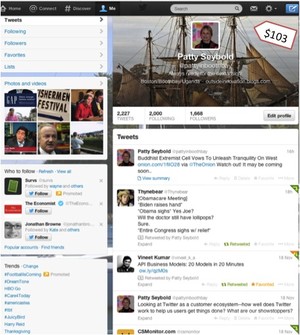How Valuable and Sustainable Is Twitter’s Customer Ecosystem?
What Is a Twitter End-Customer Worth to Investors?
Twitter is more than a social media company. It also provides the platform for a customer ecosystem with seven layers of different types of players—each benefitting from their use of Twitter’s social media platform. At the core of this ecosystem are the end-customers: the people who tweet. There are four main activities that are critical to Twitter users. All of the ecosystem players need to support these customer-critical scenarios in order to sustain the ecosystem.
NETTING IT OUT
Twitter’s Initial Public Offering on November 7th, 2013 valued the company at $14.2 billion. The stock began trading at $43.10 (73 percent higher). By the end of the first day of trading, the price per share had ramped up from $26 to $44.90, giving the company a market value of $24.5 billion. Two weeks later, the stock has settled at an average price of $42 per share. That made Twitter worth $22.4 billion. This, despite the fact that the company has never been profitable and had total revenues of $422,215,000 for the first 9 months of 2013 with a net loss of $132,852,000.
Why is Twitter valued in the $22 to $24 billion range? It is a passing fad? Or has Twitter created a sustainable and growing multi-player ecosystem that will continue to expand and to thrive?
To generate profits, Twitter and its ecosystem partners need to be good at in monetizing the value of the hundreds of millions of end-customers who post 140-character text messages—often with links to websites, articles, TV shows, videos, and photos. The actions of Twitter and its ecosystem players can’t inhibit people from tweeting enthusiastically and often. Let’s take a look at how well they’re doing.
What Are You Worth to Twitter Investors?
© 2013 Twitter and Patricia Seybold Group
Each Twitter end-customer or end-user is valuable to Twitter. We—the information about us, the people we’re connected to, and the content we tweet and/or link to—is what Twitter sells to data miners, who, in turn, resell that information widely for a variety of purposes. Advertisers rely on the demographic and interest data that Twitter collects about us to promote their products and services, and their brands. Since people tweet in real time, the analysis and ad placement happens in real time as well.
WHY IS TWITTER WORTH BILLIONS?
How Do You Calculate the Value of Any Company?
We believe that the value of any company is based on the net present value of the future profits that will be derived from its end-customers, and of its prospective end-customers. (In other words, you need to factor in assumptions about customer momentum: How rapidly will the number and activity of customers grow over the next 10 years?) Obviously there needs to be profits—if not in the near term, at least in the longer term, in order for this valuation approach to work.
Why is this important? Because if you come right down to it, your profits are derived from the value that you deliver to your end-customers. End-customers are the ones who use and benefit from your products and services. Sometimes, as in the case with Twitter or Facebook, your end-customers aren’t the ones who actually pay for the service they’re receiving. At least they don’t pay with cash. They pay by providing themselves as the product you are charging for and by contributing content and/or links.
Often, with a social media company, your end-customers create the value you’re delivering. In fact, in the social media world, your end-customers are the value you’re selling. That means that investors have to decide whether or not the social media platform is going to continue to attract users and whether they are going to continue to remain heavily engaged.
How Do You Calculate the Value of a Social Media Company?
The value of a social media company, such as Facebook or Twitter, is based on the firm’s ability to monetize its end-users by selling access to them to advertisers and by mining and benefiting from the content they’re creating. So, what matters is…(more)
(Download the PDF to read the entire article.)
Sign in to download the full article
0 comments
Be the first one to comment.




